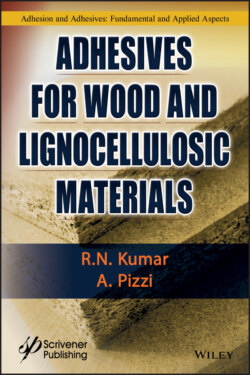Читать книгу Adhesives for Wood and Lignocellulosic Materials - R. N. Kumar - Страница 22
1.4.2 Hemicelluloses
ОглавлениеHemicelluloses are a group of heterogeneous polymers that play a supporting role in the fiber wall. Twenty to thirty percent of the dry weight of wood consists of hemicelluloses. The hemicellulose polymers are built up of several different monomers, such as mannose, arabinose, xylose, galactose, and glucose. Some acidic sugars like galacturonic acid and glucuronic acid are also constituents of hemicelluloses. One, two, or several types of monomers usually build up the backbone of hemicellulose polymers. Most of the hemicelluloses also have short branches containing types of sugars other than those of the backbone. The degree of polymerization for the hemicelluloses is between 100 and 200 [11].
Softwoods contain about 20–25% glucomannans. Acetyl groups and galactose residues are attached to the polymer chain. The hydroxyl groups at the C(2) and C(3) positions in the chain are partly substituted by O-acetyl groups. Galactose units are also attached to the chain as α-(1-6)-linkages. Hence, softwood mannans can be designated as O-acetyl-galactoglucomannans [11]. Thus, the galactoglucomannans of softwood have a backbone of (1-4) linked by β-D-glucose and β-D-mannose units in the main chain with α-D-galactose linked to the chain through (1-6)-bonds. An important structural feature is that the hydroxyl groups at C(2) and C(3) positions in the chain units are partially substituted by O-acetyl groups.
It has a backbone of (1-4)-β-D-xylose, where most of the xylose residues have an acetyl group at C(2) or C(3). About every 10th xylose unit also has a 4-O-methyl-α-D-glucuronic acid residue linked by a (1-2)-bond (Figure 1.5). The backbone substitution and degree of branching can vary considerably between hemicelluloses of the same category [19].
